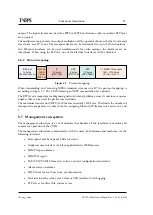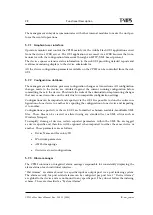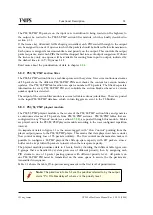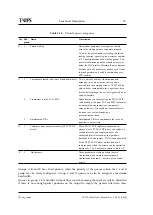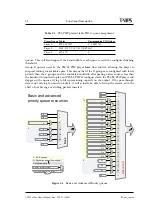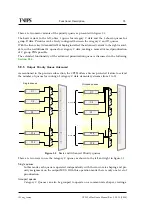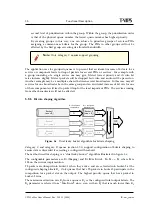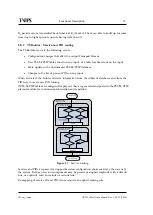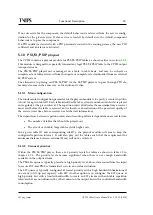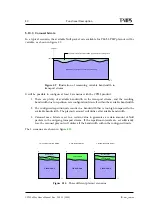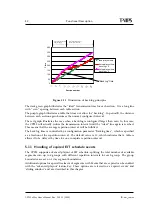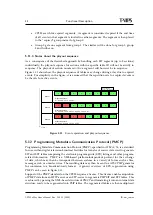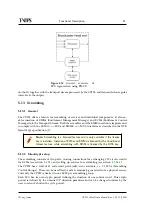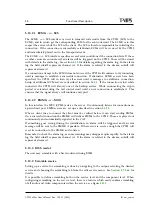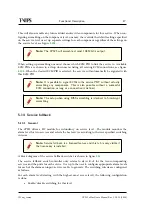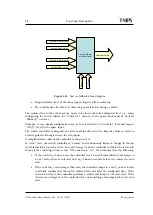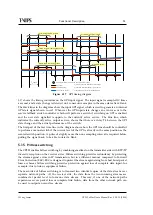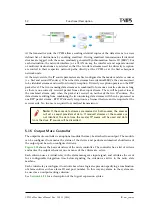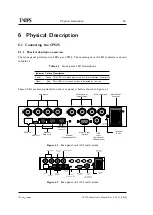
Functional Description
41
ID: um_tsmux
CP525 cMux User’s Manual Rev. 5.20.12 (3944)
For case 2 and 3, we have a
saturation
scenario, e.g. the carousel will completely fill up the
configured bandwidth. In this scenario, the configured repetition intervals will
not
be fulfilled.
All configured tables will “suffer” a certain amount. The expected behaviour for this scenario
is described in the next section.
5.10.4 Bitrate saturation handling
This chapter does not apply in ATSC mode.
In the descriptions below, we assume that the different tables are played out on
the same carousel
priority level
, for example priority level 3.
Scenario: The configured repetition intervals lead to a bandwidth that is higher than the con-
figured bandwidth. The playout carousel will continuously try to transmit tables to the output,
leaving no room for null packets at all.
In this case, the playout module will try to “spread” the resulting delay equally across all tables,
independently of configured interval.
An example may illustrate this:
•
Assume that one EIT table group is configured with
9
seconds repetition interval while
later groups are configured with
27
seconds interval and this leads to a saturation
scenario.
•
A resulting scenario in this case may be that
all
tables will suffer
3
seconds higher
repetition intervals
•
The interval for the first group will increase from
9
to
12
seconds while the interval for
the second group will increase from
27
to
30
seconds.
Note that the scenario above is just intended for illustration. In practise, the suffered delay
will vary dependent on the available bitrate in the stream. There will also be a small random
variation in the delays due to variable section lengths etc.
5.10.5 Configurable back-log time
This chapter does not apply in ATSC mode.
Refer to
regarding bitrate saturation handling. In case the output bitrate is config-
ured too low to keep up with the configured repetition intervals, each output table will “suffer”
a certain time for each repetition cycle. Compared to the “ideal” playout time, each section will
be more and more delayed.
When the output bitrate capacity becomes high enough again to keep up with the configured
repetition intervals, there are basically two ways to go:
1. Accept the resulting introduced delay and just continue using the normal repetition
interval. The wanted repetition interval has then not been achieved for the time period
that passed.
2. Try to utilise the extra capacity available and “speed up” transmission by using a lower
repetition interval. In this way, it is possible that the
average
target repetition interval
will be fulfilled.
CP525 allows for both strategies, using a configurable “back-log” time. Figure
illustrates
the concept.
Summary of Contents for CP525 cMux
Page 2: ......
Page 10: ......
Page 12: ...12 CP525 cMux User s Manual Rev 5 20 12 3944 ID um_tsmux ...
Page 18: ...18 CP525 cMux User s Manual Rev 5 20 12 3944 ID um_tsmux ...
Page 24: ...24 CP525 cMux User s Manual Rev 5 20 12 3944 ID um_tsmux ...
Page 66: ...66 CP525 cMux User s Manual Rev 5 20 12 3944 ID um_tsmux ...
Page 238: ...238 CP525 cMux User s Manual Rev 5 20 12 3944 ID um_tsmux ...
Page 248: ...248 CP525 cMux User s Manual Rev 5 20 12 3944 ID um_tsmux ...
Page 276: ...276 CP525 cMux User s Manual Rev 5 20 12 3944 ID um_tsmux ...

